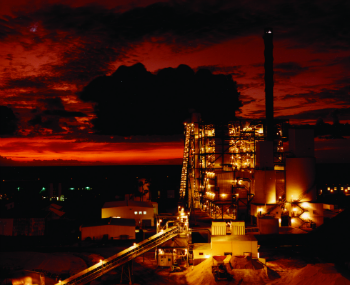I was already level with the roof on a ladder when my General Motors supervisor pointed out the irony of my situation. As an Environmental Defense Fund Climate Corps fellow, I was destroying the homes of the young maple tree seedlings trying to grow in the rain gutter of a Detroit home. I’m all for trees, but not when they take up residence in a rain gutter.
But how did I find myself on a roof in Detroit? Partly because my answer to the “are you scared of heights” question was “no,” but also because I was embedded for a summer in GM’s foundry division as part of my EDF Climate Corps fellowship.
With a background working in clean, renewable energy resources, I did not expect my next project would be on sustainability at an aluminum foundry – where raw metal inputs are melted down and cast into the desired part. However, it turns out that foundries actually consume the most energy in the vehicle manufacturing process – second only to paint – with 50 percent of the energy consumed in the furnaces used to melt and hold the metal. To assist in future energy reduction, this summer I developed a matrix to help GM compare their furnaces and aluminum foundries to realize energy savings.
For a project that sounds data-driven and office-bound, I ended up spending as many days in the office as I did outside of it. To bolster my field experience, I got the opportunity to visit all the GM-owned U.S. aluminum foundries several times to gather energy usage data and engage with the plant team about their processes.
I even got to participate in an energy “treasure hunt,” an 18-hour process (starting at thevery early time of 5 a.m.) that captures the foundry’s operational systems – including start up and shut down procedures – to see where energy can be reduced. This not only gave me an opportunity to do additional in-depth analysis for potential energy savings, but I also got to learn more about all the different people involved in running a foundry and who could help provide the data I needed.
With my first energy treasure hunt under my belt, I flew down to Mexico with three other members of GM’s global facilities team to partake in another hunt, this time at a vehicle assembly plant. Since this plant was much newer, it was harder to find potential energy savings –an exciting step in the right direction and a sign that GM is committed to reducing energy use across its operations. Newer plants are more likely to have energy efficiency solutions already in place such as efficient lighting and HVAC systems, making their energy footprint far lower than they would be at older plants.
As a whole, this fellowship was a great opportunity to get a sense not only of GM’s foundry operations, but their internal culture. Even though I was only there for 11 weeks, I feel that I got to experience what working at GM is like. I was amazed by all the different opportunities available – from international business trips to a community service event to clean up a house in Detroit.
Ultimately, I worked with both internal and external sources to develop a simplified model quantifying millions of dollars of potential savings in energy and aluminum reduction – a solid financial benefit for the company. Prior to this internship, I was completely invested in renewable energy as the solution to energy problems, but working at GM has shown me the enormous potential energy savings that can come from being innovative in energy efficiency projects as well as the benefits of participating in the larger culture.
And who knows, by saying yes to aluminum foundries and cleaning out rain gutters, I may have just found a new calling.
By Amy Chiang, student at the University of Michigan, the 2015 EDF Climate Corps fellow at General Motors
Originally Published on September 23, 2015
The Energy Exchange Blog is a forum where EDF‘s energy experts discuss how to accelerate the transition to a clean, low-carbon energy economy. Follow them on Twitter here: @EDFEnergyEX

